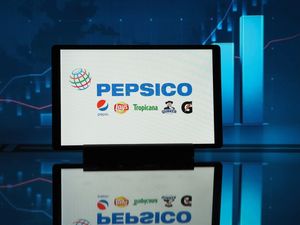Financial News
Will Cloud Soar as Retail Stumbles? Amazon Navigates Dual Fortunes Amidst AWS Boom and Consumables Squeeze

Amazon (NASDAQ: AMZN) finds itself at a pivotal juncture, charting a course through remarkably divergent fortunes across its core business segments. On one hand, its powerhouse cloud computing division, Amazon Web Services (AWS), continues to demonstrate an enviable growth trajectory, projected at around 20% year-over-year, largely fueled by the insatiable demand for artificial intelligence capabilities and broader enterprise cloud adoption. This robust expansion positions AWS as a critical engine for the company's future profitability and market valuation.
Conversely, Amazon's foundational retail sector grapples with persistent headwinds, as a pronounced market shift towards lower-margin consumables puts increasing pressure on profitability. Elevated operational costs, intense competition, and a complex fee structure for third-party sellers further compound these challenges, forcing the e-commerce giant to meticulously re-evaluate its retail strategies amidst a landscape of razor-thin margins. The dichotomy between AWS's soaring success and retail's struggles presents a compelling narrative for investors and industry observers alike.
AWS Ascends as Retail Margins Face the Squeeze
Amazon Web Services (AWS) has firmly established itself as a beacon of growth within Amazon's diverse portfolio, consistently delivering strong financial results that bolster the company's overall operating income. In Q1 2024, AWS sales surged by 17% year-over-year (YoY) to $25 billion, a performance that was echoed in Q1 2025 with another 17% YoY increase, reaching an impressive $29.3 billion. For the full fiscal year 2024, projections indicate AWS revenue will climb by 18.51% to approximately $107.56 billion. Looking ahead, analysts from TD Cowen anticipate a compelling 20% compound annual growth rate (CAGR) for AWS revenue from 2025 to 2030, with some even forecasting an acceleration beyond 20% YoY by late 2025, driven by significant investments in datacenter infrastructure. This growth is intrinsically linked to the burgeoning global cloud infrastructure market, which itself is expected to grow at an 18.91% CAGR through 2032, providing a fertile ground for AWS's continued expansion.
The primary engine behind AWS's robust growth is the unprecedented demand for Artificial Intelligence (AI), particularly generative AI. AWS is strategically investing heavily in AI infrastructure, notably in Graphics Processing Unit (GPU) capacity, and has forged critical partnerships, including a high-profile collaboration with AI startup Anthropic. Offerings like Amazon Bedrock and SageMaker are proving instrumental in attracting enterprise clients eager to deploy AI at scale. Beyond AI, the ongoing infrastructure modernization efforts by corporations and the swift adoption by small and medium-sized businesses (SMBs) and startups—which saw nearly 28% YoY growth in customer segments from 2023 to 2024—further fuel AWS's expansion. Key industries, including Media, Retail, Internet, Manufacturing, and Education, are making substantial investments in AWS cloud services, underscoring its broad appeal. Amazon's (NASDAQ: AMZN) CEO, Andy Jassy, has repeatedly highlighted generative AI's potential to significantly amplify demand for AWS, noting that companies are renewing their infrastructure modernization initiatives precisely because of AWS's advanced AI capabilities.
In stark contrast to AWS's soaring trajectory, Amazon's traditional retail sector, particularly its "Online Stores" segment, contends with an inherent struggle for profitability, primarily due to the shift towards lower-margin consumables and escalating operational costs. Historically, Amazon's retail business operated on deliberate "razor-thin margins" to discourage competition and facilitate reinvestment. However, this strategy is now facing intense pressure. The sheer volume of third-party sellers on the Amazon (NASDAQ: AMZN) marketplace creates fierce pricing wars, while substantial Amazon fees—including referral fees (8% to 45%) and Fulfillment by Amazon (FBA) fees ($2 to $6.8 per item)—significantly erode seller profits. Moreover, the logistics and supply chain costs associated with online consumer packaged goods (CPG) are considerably higher than traditional brick-and-mortar channels, directly impacting the already slender margins of consumable products. Inventory management, with its strict expectations and associated charges, further complicates the operational landscape for sellers.
Despite these significant challenges, Amazon's retail segment has shown glimpses of improved efficiency. The North America segment's operating income notably increased from $0.9 billion in Q1 2023 to $5 billion in Q1 2024, and further to $7.5 billion in Q2 2025. These improvements are largely attributed to strategic cost-cutting measures and optimizations in fulfillment operations, such as regionalization and an increase in units delivered per box. While retail margins remain substantially lower than those of AWS, these operational adjustments are crucial for sustaining the viability of its e-commerce giant amidst a highly competitive market and the persistent pressure of selling consumables. The market has generally reacted positively to AWS's strong performance, viewing it as a key driver of Amazon's overall profitability and stock performance, while closely monitoring the retail sector's efforts to enhance its more modest but still critical contributions to the bottom line.
Cloud Conquerors and Retail's Rocky Road: Discerning the Winners and Losers
The divergent paths of Amazon's (NASDAQ: AMZN) cloud and retail divisions are creating a clear delineation of winners and losers across the technology and commerce landscapes. AWS's relentless expansion, fueled by the accelerating adoption of cloud computing and Artificial Intelligence (AI), is propelling a select group of companies to new heights, while Amazon's retail challenges are intensifying pressures on traditional competitors and independent sellers alike.
Among the clearest beneficiaries of the cloud and AI boom are AWS's hyperscale competitors, notably Microsoft (NASDAQ: MSFT) Azure and Google (NASDAQ: GOOGL) Cloud Platform (GCP). While AWS maintains its leadership, these rivals are rapidly gaining market share with often higher growth rates. Microsoft Azure, leveraging its deep integration with enterprise software ecosystems, robust hybrid cloud offerings, and strategic alliances like the one with OpenAI, is spearheading AI and generative AI (GenAI) adoption for many large enterprises. Similarly, Google Cloud's growth is underpinned by its formidable strengths in data analytics, AI/Machine Learning (ML) services, and an aggressive pursuit of enterprise deals, with a higher percentage of its new public case studies featuring AI products compared to its peers. Beyond the cloud giants, AI hardware and chip manufacturers, chief among them NVIDIA (NASDAQ: NVDA), stand as indispensable providers for the AI revolution. NVIDIA’s near-monopoly in the AI Graphics Processing Unit (GPU) market, combined with its comprehensive platform of hardware, software, and networking, positions it as a critical enabler of the AI boom. Specialized cloud and infrastructure providers, such as CoreWeave, are also emerging as significant players by offering essential data center infrastructure and GPU-as-a-service.
Conversely, the struggles within Amazon's retail sector cast a long shadow over several groups. Small businesses and independent sellers on Amazon's (NASDAQ: AMZN) marketplace frequently find themselves in a precarious position, contending with high fees, stringent policies, and direct competition from Amazon's own private-label products. Amazon's pricing algorithms can penalize sellers who offer lower prices on other platforms, effectively stifling their ability to compete, while issues like counterfeiting and intellectual property infringement further erode their profitability and brand reputation. Sellers with lower Inventory Performance Index (IPI) scores may also face reduced visibility and lose eligibility for the coveted "Buy Box" and Prime status. Traditional brick-and-mortar retailers, particularly smaller establishments and those in declining mall environments, continue to feel the pressure of the ongoing shift to online shopping, a trend largely pioneered by Amazon's emphasis on convenience and competitive pricing. Many struggle to match Amazon's scale, efficiency, and customer-centric approach, which has recalibrated industry standards.
Furthermore, companies that are slow to embrace AI and automation, especially those reliant on traditional labor models that can be easily streamlined by AI-driven efficiencies, risk losing their competitive edge. Certain IT and business process outsourcing services may face disintermediation or commoditization as AI-powered automation becomes more prevalent. While Amazon's vast logistics network is a formidable asset, over-reliance on Amazon as a partner can be a double-edged sword for external logistics providers and suppliers, as Amazon's immense leverage often leads to demands for price concessions. As Amazon itself invests billions in AI for its own logistics and warehouse operations, aiming for substantial savings and efficiency gains, this strategic pivot could potentially diminish its long-term reliance on certain external partners or human labor. Competing large retailers that fail to innovate and effectively adapt, despite the resilience shown by some like Walmart (NYSE: WMT) and Target (NYSE: TGT) through omnichannel strategies, will continue to face significant pressure from Amazon's pervasive market presence and the evolving demands of consumers.
Industry Tides: Cloud's Ascent and Retail's Evolving Landscape
The remarkable divergence between AWS's surging growth and Amazon's (NASDAQ: AMZN) retail sector's challenges is more than an internal corporate narrative; it reflects and drives broader industry trends, creating significant ripple effects across the global economy. This dynamic scenario underscores a fundamental shift in value creation within the technology and commerce spheres, with profound implications for competitors, partners, and regulators.
AWS's robust performance is a direct manifestation of the accelerating global embrace of cloud adoption and digital transformation. The cloud computing market is experiencing exponential growth, with global spending on cloud infrastructure services projected to reach $1.6 trillion by 2030, boasting a compound annual growth rate (CAGR) of 17.2% from 2025 to 2030. AWS maintains its dominant position, consistently holding around 30-31% of the global cloud infrastructure market. A critical catalyst for this expansion is the insatiable demand for Artificial Intelligence (AI) and Machine Learning (ML) capabilities, particularly generative AI, which has turbocharged cloud service development since late 2022. AWS's strategic investments in data center capacity, specialized AI hardware like Trainium2 chips, and platforms such as Bedrock are meticulously designed to capitalize on this trend. The inherent scalability, flexibility, cost efficiency, and enhanced security of cloud platforms are compelling businesses of all sizes to migrate their workloads, solidifying cloud computing as the new backbone of the digital economy.
Conversely, Amazon's retail sector challenges mirror broader evolutionary pressures within e-commerce and traditional retail. While the "Amazon effect" has undeniably reshaped consumer expectations for speed, convenience, and personalization, e-commerce itself is now navigating a landscape of intense competition, supply chain disruptions, and escalating operational costs. The sheer proliferation of online ventures intensifies pricing pressure, while consumers' elevated expectations for faster deliveries and seamless returns demand significant logistical and technological investments. Amazon's marketplace model, despite offering independent sellers access to a vast audience, often entails high fees and stringent policies, pushing some merchants to diversify their sales channels and explore alternative platforms like Shopify (NYSE: SHOP) or even newer entrants like Temu. These dynamics are compelling the entire retail industry to innovate rapidly, optimize supply chains, and strategically leverage technology to meet ever-evolving customer demands while battling margin compression.
The growing market dominance of Amazon (NASDAQ: AMZN) in both cloud computing and e-commerce has not gone unnoticed by regulators, attracting increasing antitrust scrutiny worldwide. The Federal Trade Commission (FTC) filed a complaint against Amazon in September 2023, alleging monopolistic practices in e-commerce, including sophisticated pricing algorithms that deter sellers from offering lower prices elsewhere and control over the "Buy Box." Concerns also extend to Amazon's private label brands potentially undercutting competitors. In the cloud sector, the combined market share of the "Big Three" (AWS, Microsoft (NASDAQ: MSFT) Azure, and Google (NASDAQ: GOOGL) Cloud) exceeding 60% raises questions about market concentration. Proposed legislation targeting "self-preferencing" practices, where a platform might favor its own products or services over third-party offerings, could significantly impact how Amazon operates its marketplace and search results. Furthermore, the immense volumes of data handled by AWS and Amazon retail amplify concerns regarding data privacy and security, particularly with the integration of AI, leading to increased regulatory oversight in these areas. Historically, this scenario of a highly successful, rapidly growing segment coexisting with a dominant but challenged legacy business echoes precedents like IBM's (NYSE: IBM) transition from mainframe hardware to services or Microsoft's evolution from OS dominance to cloud and enterprise solutions, both of which faced significant antitrust scrutiny during their periods of market transformation. These historical parallels underscore that adaptation, the cultivation of new growth engines, and inevitable regulatory oversight are hallmarks of market leadership in evolving industries.
The Road Ahead: AWS's AI Horizon and Retail's Reinvention
The future trajectory of Amazon (NASDAQ: AMZN) will be defined by its ability to capitalize on AWS's unprecedented growth potential while strategically reinjecting vitality and efficiency into its challenged retail arm. The company stands at a pivotal juncture, requiring adept navigation of technological innovation, evolving market demands, and intensified competition to secure its long-term dominance across both critical segments.
In the short term, AWS is laser-focused on cementing its leadership in cloud computing by aggressively investing in artificial intelligence, particularly generative AI. Despite recent growth slowdowns compared to rivals like Microsoft (NASDAQ: MSFT) Azure and Google (NASDAQ: GOOGL) Cloud, largely due to customer optimization efforts and substantial capital expenditures in AI infrastructure, AWS is projected to invest $118 billion in AI infrastructure for 2025. This commitment includes developing custom AI chips, such as Trainium2 and Inferentia, to gain greater control over its AI computing stack and offer superior price-performance, addressing the global shortage of GPUs. While short-term challenges like hardware shortages and energy supply for data centers exist, these constraints are expected to ease later in 2025, enabling more effective scaling. Long-term, AWS envisions sustained market dominance, with aspirations to become a $100 billion business by 2025 and capture over 40% of worldwide cloud revenues within five years. Its strategy encompasses a comprehensive generative AI approach through services like Amazon Bedrock and AI assistants such as Amazon Q, along with continued expansion of its global infrastructure and tailored industry-specific solutions for sectors like healthcare and finance. The shift of 85-90% of IT spending still remaining on-premises represents a colossal $500 billion AI-as-a-service market opportunity that AWS is poised to seize.
For its retail division, Amazon (NASDAQ: AMZN) is navigating a period of strategic restructuring and aggressive cost-cutting measures. This includes freezing hiring budgets and streamlining managerial roles to prioritize operational efficiency amidst slowing growth and heightened competition from players like Walmart (NYSE: WMT) and Shopify (NYSE: SHOP). A significant short-term pivot involves bolstering its burgeoning advertising business, which is growing faster than traditional e-commerce and logistics and is projected to exceed $94 billion in global revenue by 2026. Long-term, Amazon's retail vision hinges on deep AI integration, with a substantial $25 billion investment in AI for logistics—aiming for $10 billion in savings by 2030 through route optimization and predictive inventory systems. This extends to leveraging AI for personalized recommendations and automated inventory management. The evolution of its physical retail presence, particularly in the grocery segment with Amazon Fresh, Whole Foods Market, and Amazon Go stores featuring "Just Walk Out" technology, is crucial for an integrated omnichannel experience and micro-fulfillment goals. Strategic adaptations for retail include seamless online and physical integration, further automation with hundreds of thousands of robots in warehouses to cut labor costs, and encouraging sellers to build robust brands amidst competitive marketplace dynamics.
Potential scenarios for AWS include solidifying its position as the dominant AI cloud provider if it successfully overcomes infrastructure constraints and maintains its innovation pace, or facing intensified margin pressures from fierce competition if a distinct technological edge isnates. For retail, extensive AI integration could lead to unparalleled efficiency and personalization, further cementing market dominance and improving profitability. A successful integration of physical stores, particularly in grocery, could redefine omnichannel retail. Conversely, if physical store strategies falter, Amazon might further reduce its brick-and-mortar footprint. The advertising business is set to become an increasingly critical profit engine, diversifying Amazon's revenue streams. However, sustained growth across both segments will inevitably invite heightened regulatory scrutiny over market dominance and data privacy, while market saturation in key e-commerce regions will necessitate more aggressive international expansion. Amazon's historical commitment to prioritizing long-term growth and innovation over immediate profitability will be the guiding principle as it adapts to these complex and rapidly evolving market dynamics.
Navigating the Dual Tide: Amazon's Strategic Imperative
Amazon's (NASDAQ: AMZN) current landscape is best understood as a strategic balancing act, where the robust and highly profitable growth of Amazon Web Services (AWS) serves as a critical counterbalance to the persistent, albeit evolving, challenges within its foundational retail sector. This dual identity underscores Amazon's continuous transformation from a pure e-commerce giant to a dominant technology infrastructure provider, with profound implications for its future and the broader market.
The key takeaway is the undeniable ascendancy of AWS, which continues to drive a significant portion of Amazon's operating income and fuels its ambitious investments, particularly in the burgeoning field of Artificial Intelligence. AWS's strategic prioritization, evidenced by capital expenditures surpassing those of the retail segment, signals Amazon's long-term bet on cloud computing and AI as the core pillars of future revenue and innovation. While AWS maintains its market leadership, the intensifying competition from Microsoft (NASDAQ: MSFT) Azure and Google (NASDAQ: GOOGL) Cloud means that sustained aggressive investment and innovation in AI-optimized services will be paramount for AWS to maintain its growth momentum and market share.
Concurrently, Amazon's retail arm faces a complex array of challenges, from slowing growth and fierce competition to the inherent low margins of consumables and the complexities of managing a vast third-party marketplace. However, Amazon is not passively accepting these headwinds. Its strategic pivot involves deep integration of AI into logistics, fulfillment, and customer experience, aiming for significant long-term efficiency gains and a redefinition of its retail offering beyond traditional sales. The rapid growth of its advertising business also provides a crucial diversification of revenue, offering a higher-margin counterpoint to retail's inherent pressures. This synergy, where AWS innovations empower both external businesses and Amazon's internal retail operations, represents a unique and powerful competitive advantage.
For investors, the coming months will require diligent observation of several key indicators. Foremost among these is the growth trajectory of AWS relative to its hyperscale competitors; any acceleration in AWS revenue growth, stemming from its AI investments, will be a strong positive signal. The impact of Amazon's substantial capital expenditures on short-term profitability and free cash flow also warrants close scrutiny. Improvements in retail operating margins, indicative of successful efficiency gains from AI integration, will be crucial for the overall financial health of the company. Finally, tangible evidence of AI's positive impact, both in the form of new AWS services and measurable enhancements in retail efficiency and customer experience, will provide critical insights into the return on Amazon's strategic bets. While analysts generally maintain an optimistic outlook, the ongoing market volatility suggests a cautious approach, with clearer directional clarity potentially emerging after upcoming quarterly earnings reports that shed more light on the returns on Amazon's aggressive AI investments. The lasting impact of this period will be Amazon's further cementing its role as an indispensable global infrastructure provider, while simultaneously evolving its retail core into a highly efficient, AI-driven engine for consumer commerce.
More News
View More





Quotes delayed at least 20 minutes.
By accessing this page, you agree to the following
Privacy Policy and Terms Of Service.



